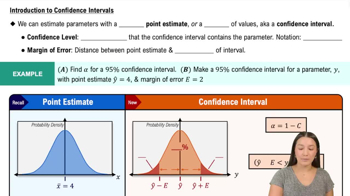Are Nuclear Plants Safe? In a Gallup poll of 1038 adults, 47% said that nuclear plants are safe, 49% said that they are not safe, and 4% had no opinion. Construct a 95% confidence interval estimate of the proportion of all adults who say that nuclear plants are safe. Based on the result, can we conclude that fewer than half of all adults say that nuclear plants are safe?
Table of contents
- 1. Intro to Stats and Collecting Data1h 14m
- 2. Describing Data with Tables and Graphs1h 55m
- 3. Describing Data Numerically2h 5m
- 4. Probability2h 16m
- 5. Binomial Distribution & Discrete Random Variables3h 6m
- 6. Normal Distribution and Continuous Random Variables2h 11m
- 7. Sampling Distributions & Confidence Intervals: Mean3h 23m
- Sampling Distribution of the Sample Mean and Central Limit Theorem19m
- Distribution of Sample Mean - Excel23m
- Introduction to Confidence Intervals15m
- Confidence Intervals for Population Mean1h 18m
- Determining the Minimum Sample Size Required12m
- Finding Probabilities and T Critical Values - Excel28m
- Confidence Intervals for Population Means - Excel25m
- 8. Sampling Distributions & Confidence Intervals: Proportion1h 12m
- 9. Hypothesis Testing for One Sample3h 29m
- 10. Hypothesis Testing for Two Samples4h 50m
- Two Proportions1h 13m
- Two Proportions Hypothesis Test - Excel28m
- Two Means - Unknown, Unequal Variance1h 3m
- Two Means - Unknown Variances Hypothesis Test - Excel12m
- Two Means - Unknown, Equal Variance15m
- Two Means - Unknown, Equal Variances Hypothesis Test - Excel9m
- Two Means - Known Variance12m
- Two Means - Sigma Known Hypothesis Test - Excel21m
- Two Means - Matched Pairs (Dependent Samples)42m
- Matched Pairs Hypothesis Test - Excel12m
- 11. Correlation1h 6m
- 12. Regression1h 50m
- 13. Chi-Square Tests & Goodness of Fit1h 57m
- 14. ANOVA1h 57m
8. Sampling Distributions & Confidence Intervals: Proportion
Confidence Intervals for Population Proportion
Problem 9.1.25a
Textbook Question
Overlap of Confidence Intervals In the article “On Judging the Significance of Differences by Examining the Overlap Between Confidence Intervals,” by Schenker and Gentleman (American Statistician, Vol. 55, No. 3), the authors consider sample data in this statement: “Independent simple random samples, each of size 200, have been drawn, and 112 people in the first sample have the attribute, whereas 88 people in the second sample have the attribute.”
a. Use the methods of this section to construct a 95% confidence interval estimate of the difference p1-p2. What does the result suggest about the equality of p1 and p2
.
 Verified step by step guidance
Verified step by step guidance1
Step 1: Identify the problem and the given data. We are tasked with constructing a 95% confidence interval for the difference between two population proportions (p1 - p2). The given data includes two independent random samples: Sample 1 has n1 = 200 and x1 = 112, while Sample 2 has n2 = 200 and x2 = 88.
Step 2: Calculate the sample proportions for each group. The sample proportion for the first group is p̂1 = x1 / n1, and for the second group, it is p̂2 = x2 / n2. These proportions represent the observed frequencies of the attribute in each sample.
Step 3: Compute the standard error (SE) for the difference between the two proportions. The formula for the standard error is: SE = sqrt((p̂1 * (1 - p̂1) / n1) + (p̂2 * (1 - p̂2) / n2)). This accounts for the variability in both sample proportions.
Step 4: Determine the critical value for a 95% confidence level. For a two-tailed test, the critical value corresponds to the z-score associated with 95% confidence, which is approximately 1.96. This value will be used to calculate the margin of error.
Step 5: Construct the confidence interval for the difference (p1 - p2). The formula is: (p̂1 - p̂2) ± (z * SE), where z is the critical value and SE is the standard error. Interpret the interval to assess whether it includes 0, which would suggest equality between p1 and p2.
 Verified video answer for a similar problem:
Verified video answer for a similar problem:This video solution was recommended by our tutors as helpful for the problem above
Video duration:
5mPlay a video:
Was this helpful?
Key Concepts
Here are the essential concepts you must grasp in order to answer the question correctly.
Confidence Interval
A confidence interval is a range of values, derived from sample statistics, that is likely to contain the true population parameter with a specified level of confidence, typically 95%. It provides an estimate of uncertainty around a sample statistic, allowing researchers to infer about the population. For example, if a 95% confidence interval for the difference in proportions is calculated, it suggests that if the same sampling method were repeated, 95% of the intervals would contain the true difference.
Recommended video:

Introduction to Confidence Intervals
Difference in Proportions
The difference in proportions refers to the comparison of two population proportions, denoted as p1 and p2. In the context of the question, it involves calculating the difference between the proportion of individuals with a certain attribute in two independent samples. This difference helps in assessing whether there is a statistically significant disparity between the two groups, which can be crucial for hypothesis testing.
Recommended video:
Guided course

Difference in Proportions: Hypothesis Tests
Hypothesis Testing
Hypothesis testing is a statistical method used to make inferences about population parameters based on sample data. In this context, it involves testing the null hypothesis that p1 equals p2 against the alternative hypothesis that they are not equal. The results from the confidence interval can indicate whether the null hypothesis can be rejected, thus providing insights into the equality or difference of the two proportions.
Recommended video:
Guided course

Step 1: Write Hypotheses

 5:45m
5:45mWatch next
Master Constructing Confidence Intervals for Proportions with a bite sized video explanation from Patrick
Start learningRelated Videos
Related Practice
Textbook Question
